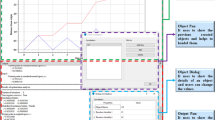Abstract
Qualitative reasoning is a methodology for deriving the behavior of a device from a declarative representation of relevant fundamental principles and a high-level description of the device. This article and its companion present a qualitative reasoning framework, named the space-centered framework, for reasoning about the behavior of structural systems subjected to loads. The framework includes a representation of the topology and geometry of a structure, and the fundamental principles of equilibrium, compatibility and force-deformation relationships. A parameter, such as a displacement or an internal force, is represented qualitatively by its algebraic sign and its relationship in magnitude with other parameters in the model. Component qualitative states incorporate the fundamental principles for a class of components, such as frame members or supports. The conjugate analogy between the equilibrium and compatibility laws is recognized in the representation. Processes acting between components represent fundamental principles of equilibrium and compatibility at the connections. A companion paper presents the inference strategy for the space-centered framework and its application to qualitative analysis of conceptual designs of structures.
Similar content being viewed by others
References
Bozzo, L. M. and Fenves, G. L., “Qualitative Reasoning Inference Strategy and its Applications in Structural Engineering”,Research in Engineering Design, 1994.
Bozzo, L. M. and Fenves, G. L., “Qualitative Reasoning About Structural Behavior for Conceptual Design”,SEMM Report UCB/SEMM 92/26, Department of Civil Engineering, University of California at Berkeley, 1992.
Cohn, A., “Qualitative Reasoning”,Advanced Topics in Artificial Intelligence, 2nd Advanced Course, ACAI '87, Nossum, R. (ed.), Oslo, Norway, pp. 60–95, 1987.
De Kleer, J. and Brown, J., “A Qualitative Physics Based on Confluences”,Artificial Inteligence, vol. 24, pp. 7–93, 1984.
Del Grosso, A. and Zucchini, A., “Qualitative Physics and its Applications to Structural Engineering Systems”,U.S.-Italy-Japan Workshop/Seminar on Intelligent Systems, Perugia, Italy (personal communication with the authors).
Forbus, K., “Qualitative Process Theory”,Artificial Intelligence, vol. 24, pp. 85–168, 1984.
Forbus, K., “Qualitative Physics: Past, Present and Future”,Readings in Qualitative Reasoning About Physical Systems, Weld, D. and De Kleer, J. (eds), Morgan Kaufmann, San Mateo, Calif., pp. 11–39, 1990.
Fruchter, R., Iwasaki, Y. and Law, K., “Generating Qualitative Models for Structural Analysis and Design”,Proceedings, Seventh Conference on Computing in Civil Engineering, ASCE, Washington, DC, pp. 268–277, 1991.
Ganguly, J., Kausel, E. and Sriram, D., “OSEIS: A System for Deriving Qualitative Seismic Behavior of Structural Systems from Structural Descriptions”,Artificial Intelligence in Compound Engineering, Kleiber, M. (ed.). Ellis Horwood, New York, 1990.
Kuipers, B., “Commonsense Reasoning About Causality: Deriving Behavior From Structure”,Artificial Intelligence, vol. 24, pp. 169–203, 1984.
Roddis, K., Heuristic, “Qualitative and Quantitative Reasoning About Steel Fatigue and Fracture”, PhD dissertation, Massachusetts Institute of Technology, Cambridge, MA, 1988.
Schwartz, D. and Chen, S., “Order of Magnitude Reasoning for Qualitative Matrix Structural Analysis”,Proceedings, Fifth International Conference in Computing in Civil and Building Engineering, Cohn, L. (ed.), ASCE, New York, pp. 1267–1274, 1993.
Slater, J., “Qualitative Physics and the Prediction of Structural Behavior”,Proceedings of ASCE Symposium Expert Systems in Civil Engineering, Kostem, C. and Maher, M. (eds), ASCE, New York, pp. 239–248, 1986.
Subramani, M., Gergely, P., Conley, C., Abel, J. and Zaghw, A., “A Knowledge-Based Approach to Structural Design of Earthquake-Resistant Buildings”,Report NCEER-89-0006, National Center for Earthquake Engineering Research, State University of New York at Buffalo, 1989
Author information
Authors and Affiliations
Rights and permissions
About this article
Cite this article
Bozzo, L.M., Fenves, G.L. Qualitative reasoning and the representation of fundamental principles in structural engineering. Research in Engineering Design 6, 61–72 (1994). https://doi.org/10.1007/BF01579984
Issue Date:
DOI: https://doi.org/10.1007/BF01579984




